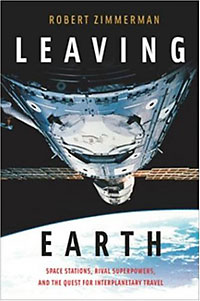Review: Leaving Earthby Jeff Foust
|
| “Like ships passing in the night,” Zimmerman notes, “the Russians have become freedom-loving capitalists, while the Americans have become xenophobic control-freaks.” |
Throughout Leaving Earth Zimmerman notes how the development of these stations has enabled, step by step, human explorations beyond Earth orbit. This includes the ability of humans to spend increasing periods of time in weightlessness—three months, six months, a year and more—with only temporarily affects to their health, as well as the technical achievements of the stations themselves. In addition, he also follows a long-term Russian effort, dating from Salyut 1 and extending through Mir and ISS, to grow plants in space: a key requirement, in all likelihood, of any long-duration human mission to Mars and beyond.
Because Leaving Earth covers events that span more than three decades, Zimmerman also explores how the Russian and American space programs have evolved over that time. He concludes that the two have been, and continue, to move in opposite directions. Russian efforts have gone from the autocratic control of Soviet times to the present day, where Russia is willing to sell seats on Soyuz taxi flights to the ISS and film commercials there, doing whatever it takes to raise the money needed to keep their program alive. NASA, in the meantime, has gone from the can-do days of Apollo to an increasingly centralized, government-controlled present. Zimmerman even compares the internecine squabbles among the NASA field centers for control of the space station program to the disputes between Korolev’s and Chelomey’s design bureaus in the 1960s Soviet Union. “Like ships passing in the night,” he writes, “the Russians have become freedom-loving capitalists, while the Americans have become xenophobic control-freaks.”
Leaving Earth offers perhaps the best single-volume history of space station development yet written. Given how unfamiliar most Americans, even those who consider themselves space advocates, are of Russian space history, this book does a valuable service by introducing them to the cosmonauts who pioneered space station development for decades. One drawback of the book, though, it that it doesn’t include any photographs, only a handful of line drawings of the various space stations flown to date. This keeps the reader from putting a face on many of those people, as well as the space stations they inhabited.
Towards the end of the book Zimmerman argues that the ISS is something of a step backwards from Mir and its predecessors. While those stations were designed to be increasingly independent—“with Mir we almost had a closed loop,” claimed ISS and Mir veteran Sergei Krikalev—ISS is more complex and thus more dependent on ground controllers to operate. Given the vast distances of interplanetary space, where the round-trip travel time for a message and its response is measured in the dozens of minutes, that’s no way to operate. However, since the book’s publication last fall President Bush has introduced a new space policy with the goals of returning humans to the Moon and, eventually, sending them on to Mars. One aspect of that plan is to focus the ISS on life sciences research that directly supports that exploration initiative. While doubtless a disappointment to those who planned to perform material or physical science research on the station, this redirection may put the ISS firmly back on course towards the ultimate goals pioneered by the Salyuts, Skylab, and Mir: to lead humanity into the solar system.
